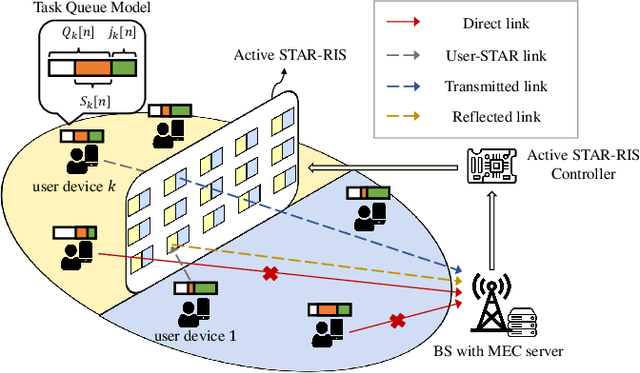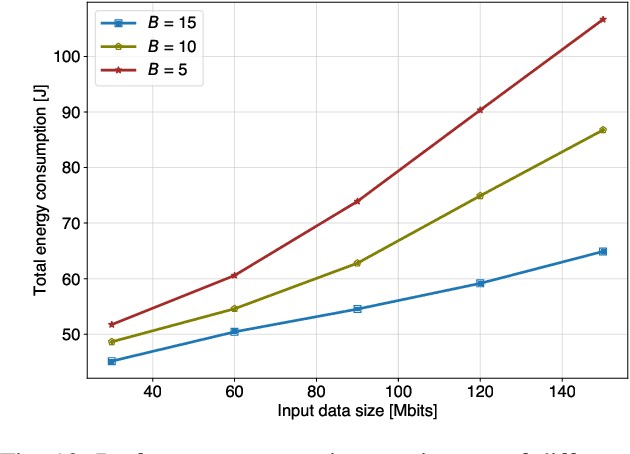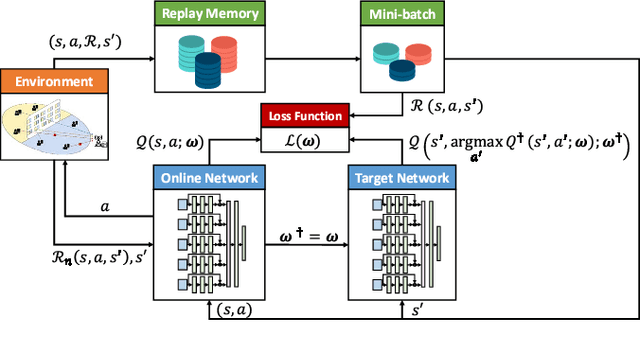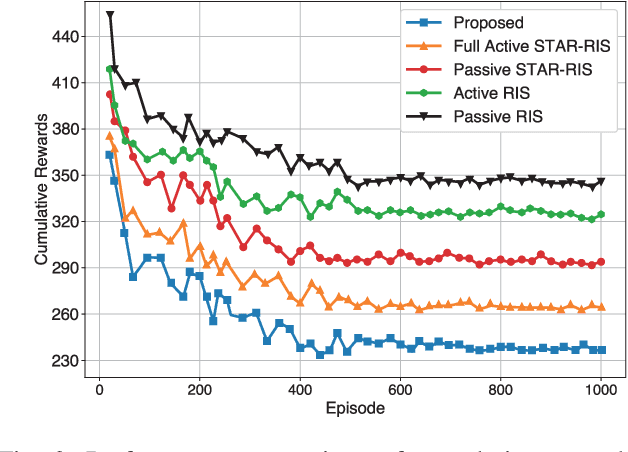Pyae Sone Aung
Active STAR-RIS Empowered Edge System for Enhanced Energy Efficiency and Task Management
Aug 23, 2024



Abstract:The proliferation of data-intensive and low-latency applications has driven the development of multi-access edge computing (MEC) as a viable solution to meet the increasing demands for high-performance computing and storage capabilities at the network edge. Despite the benefits of MEC, challenges such as obstructions cause non-line-of-sight (NLoS) communication to persist. Reconfigurable intelligent surfaces (RISs) and the more advanced simultaneously transmitting and reflecting (STAR)-RISs have emerged to address these challenges; however, practical limitations and multiplicative fading effects hinder their efficacy. We propose an active STAR-RIS-assisted MEC system to overcome these obstacles, leveraging the advantages of active STAR-RIS. The main contributions consist of formulating an optimization problem to minimize energy consumption with task queue stability by jointly optimizing the partial task offloading, amplitude, phase shift coefficients, amplification coefficients, transmit power of the base station (BS), and admitted tasks. Furthermore, we decompose the non-convex problem into manageable sub-problems, employing sequential fractional programming for transmit power control, convex optimization technique for task offloading, and Lyapunov optimization with double deep Q-network (DDQN) for joint amplitude, phase shift, amplification, and task admission. Extensive performance evaluations demonstrate the superiority of the proposed system over benchmark schemes, highlighting its potential for enhancing MEC system performance. Numerical results indicate that our proposed system outperforms the conventional STAR-RIS-assisted by 18.64\% and the conventional RIS-assisted system by 30.43\%, respectively.
Aerial STAR-RIS Empowered MEC: A DRL Approach for Energy Minimization
Dec 14, 2023Abstract:Multi-access Edge Computing (MEC) addresses computational and battery limitations in devices by allowing them to offload computation tasks. To overcome the difficulties in establishing line-of-sight connections, integrating unmanned aerial vehicles (UAVs) has proven beneficial, offering enhanced data exchange, rapid deployment, and mobility. The utilization of reconfigurable intelligent surfaces (RIS), specifically simultaneously transmitting and reflecting RIS (STAR-RIS) technology, further extends coverage capabilities and introduces flexibility in MEC. This study explores the integration of UAV and STAR-RIS to facilitate communication between IoT devices and an MEC server. The formulated problem aims to minimize energy consumption for IoT devices and aerial STAR-RIS by jointly optimizing task offloading, aerial STAR-RIS trajectory, amplitude and phase shift coefficients, and transmit power. Given the non-convexity of the problem and the dynamic environment, solving it directly within a polynomial time frame is challenging. Therefore, deep reinforcement learning (DRL), particularly proximal policy optimization (PPO), is introduced for its sample efficiency and stability. Simulation results illustrate the effectiveness of the proposed system compared to benchmark schemes in the literature.
Training A Semantic Communication System with Federated Learning
Oct 20, 2023



Abstract:Semantic communication has emerged as a pillar for the next generation of communication systems due to its capabilities in alleviating data redundancy. Most semantic communication systems are built using advanced deep learning models whose performance heavily depends on data availability. These studies assume that an abundance of training data is available, which is unrealistic. In practice, data is mainly created on the user side. Due to privacy and security concerns, the transmission of data is restricted, which is necessary for conventional centralized training schemes. To address this challenge, we explore semantic communication in federated learning (FL) setting that utilizes user data without leaking privacy. Additionally, we design our system to tackle the communication overhead by reducing the quantity of information delivered in each global round. In this way, we can save significant bandwidth for resource-limited devices and reduce overall network traffic. Finally, we propose a mechanism to aggregate the global model from the clients, called FedLol. Extensive simulation results demonstrate the efficacy of our proposed technique compared to baseline methods.
 Add to Chrome
Add to Chrome Add to Firefox
Add to Firefox Add to Edge
Add to Edge